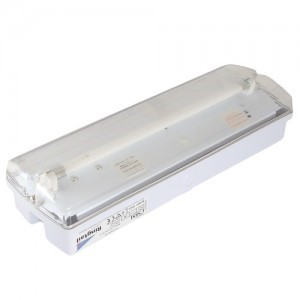
In the event of an emergency, you can’t afford to be left in the dark. Making sure those emergency lights are working is a safety must. In this blog we focus on what emergency lighting is, and what you must know in terms of testing and compliance.
Emergency lighting, as one might expect, is for an emergency situation when the power supply fails and normal lighting has failed. There are many reasons why there could be a power cut, some that may potentially prove a risk to others, such as a deadly fire. The sudden darkness can lead to possible danger and panic.
Emergency lighting is a general term and is sub-divided into emergency escape lighting and standby lighting.
This element of an emergency lighting system that provides illumination for the safety of people leaving a building, perhaps during a situation that requires the building to be evacuated such a putting out a fire. This is part of the fire safety provision of a building an a requirement of The Regulatory Reform (Fire Safety) Order 2005.
This is lighting provided for normal activities to continue in the event of a power cut. This blog doesn’t cover standby lighting as it is not a legal requirement
Emergency escape lighting is itself sub-divided into escape route lighting, open area lighting and high risk task area lighting.
Escape route lighting – That part of an emergency escape lighting system provided to ensure that the means of escape can be effectively identified and safely used by occupants of the building.

Emergency Exit Light
Open area lighting (in some countries known as anti-panic lighting) – that part of an emergency escape lighting system provided to minimise panic and ensure there is sufficient lighting to allow the occupants of a building to reach an area where an escape route can be identified.

Bulkhead emergency lighting
High risk task area lighting – That part of an emergency escape lighting system that provides illumination for the safety of people involved in a potentially dangerous process or situation and to enable proper shut-down procedures for the safety of the operator and other occupants of the premises.
To test an emergency lighting system, simulating a power failure by cutting the power is the standard way of testing. This will then, hopefully, activate the lights. This can be done both manually or automatically.
A simulated mains failure can be achieved by providing a switch to isolate all lighting circuits / individual circuits / individual luminaires. If manual testing is utilised, the following points should be considered:
In a system with a single switch for the whole building or a large circuit, after simulating the mains failure it is necessary for the tester to walk the whole building or circuit, to check all emergency luminaire are operating correctly. After restoring the mains supply, the whole building or circuit must be walked again, to check that the emergency lights are recharging.
If the emergency luminaires are individually switched, only a single walk around the building will be needed. However, the test switches could spoil the decor of the building and they must be of a type that is tamper proof. After the tests, it is a good idea to log all the results for future reference.
If the costs of an engineer’s time and the disruption caused by manual testing are excessive, self-testing emergency lighting should be considered. Different formats are available to match particular site requirements. However, the results of the monthly and annual tests must still be recorded.
Regular servicing is essential. The occupier / owner of the premises should appoint a competent person to supervise servicing of the system. This person shall be given sufficient authority to ensure the carrying out of any work necessary to maintain the system in correct operational mode.
Because of the possibility of a failure of the normal lighting supply occurring shortly after a period of testing of the emergency lighting system or during the subsequent recharge period, all full duration tests shall, wherever possible, be undertaken just before a time of low risk to allow for battery recharge. Alternatively, suitable temporary arrangements shall be made until the batteries have been recharged.
The following minimum inspections and tests shall be carried out at the intervals recommended below. The regulating authority may require specific tests.
This check only applies to emergency lighting systems with a central back-up battery system. In this case, there is a daily visual inspection of indicators on the central power supply to identify that the system is operational. No test of operation is required. This test does not apply to emergency lighting with self-contained back-up batteries in each unit (standard emergency lighting).
All emergency lighting systems must be tested monthly. The test is a short functional test in accordance with BS EN 50172:2004 / BS 5266-8:2004.
The period of simulated failure should be sufficient for the purpose of this test while minimising damage to the system components, e.g. lamps. During this period, all luminaires and signs shall be checked to ensure that they are present, clean and functioning correctly.
A test for the full rated duration of the emergency lights (e.g. 3 hours) must be carried out. The emergency lights must still be working at the end of this test.
The result must be recorded and, if failures are detected, these must be remedied as soon as possible.
It is common for fire alarm servicing companies to carry out the annual emergency light ‘drain’ test at the same time as they carry out fire alarm system maintenance, as this fills the waiting time of the ‘drain’ test with useful activity.
Karsons conduct maintenance audits where we review all requirements or testing of emergency lighting as well as other statuary requirement. Contact us for a free consultation.
Karsons Consulting are members of the Chartered Institute of Building Services Engineers, The Association of Consultancy and Engineering, British Institute of Facilities Managers and the Building Services Research and Information Association.